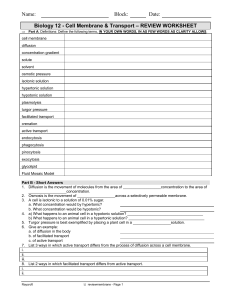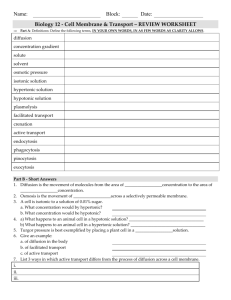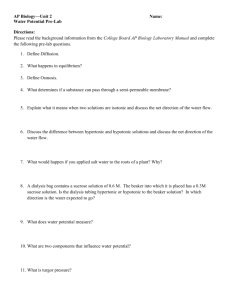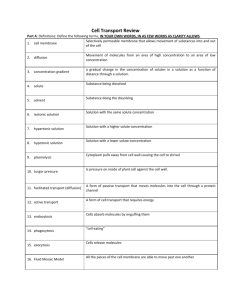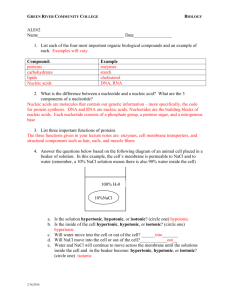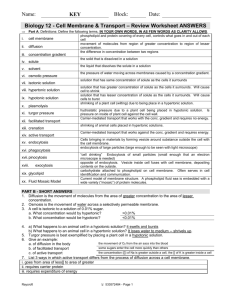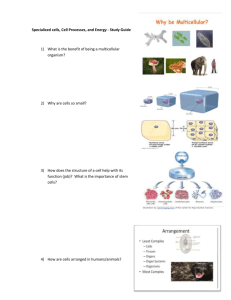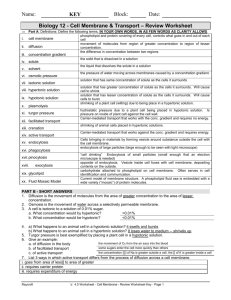Biology 12 - Cell Membrane & Transport – REVIEW WORKSHEET
advertisement
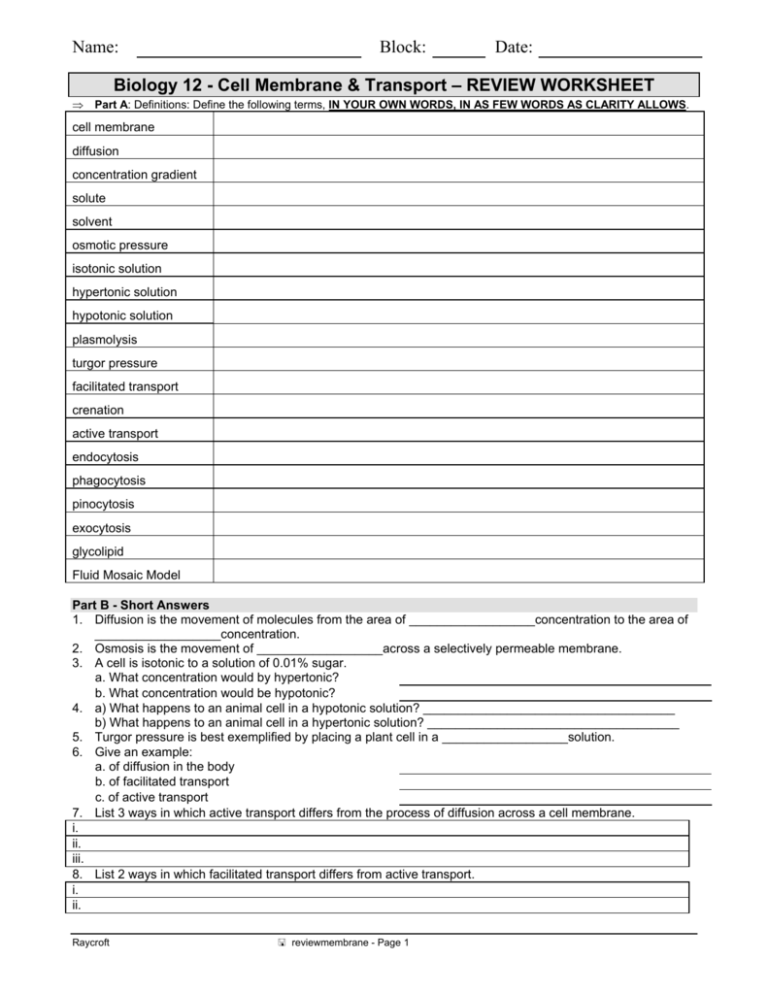
Name: Block: Date: Biology 12 - Cell Membrane & Transport – REVIEW WORKSHEET ⇒ Part A: Definitions: Define the following terms, IN YOUR OWN WORDS, IN AS FEW WORDS AS CLARITY ALLOWS. cell membrane diffusion concentration gradient solute solvent osmotic pressure isotonic solution hypertonic solution hypotonic solution plasmolysis turgor pressure facilitated transport crenation active transport endocytosis phagocytosis pinocytosis exocytosis glycolipid Fluid Mosaic Model Part B - Short Answers 1. Diffusion is the movement of molecules from the area of __________________concentration to the area of __________________concentration. 2. Osmosis is the movement of __________________across a selectively permeable membrane. 3. A cell is isotonic to a solution of 0.01% sugar. a. What concentration would by hypertonic? b. What concentration would be hypotonic? 4. a) What happens to an animal cell in a hypotonic solution? ____________________________________ b) What happens to an animal cell in a hypertonic solution? ____________________________________ 5. Turgor pressure is best exemplified by placing a plant cell in a __________________solution. 6. Give an example: a. of diffusion in the body b. of facilitated transport c. of active transport 7. List 3 ways in which active transport differs from the process of diffusion across a cell membrane. i. ii. iii. 8. List 2 ways in which facilitated transport differs from active transport. i. ii. Raycroft reviewmembrane - Page 1 9. Within each of the three pairs, choose the more concentrated solution: Pairs a. 80% water, 20% starch b. 90% water, 10% starch a. 5 g NaCl, 50 g water b. 5 g NaCl, 25 g water 85% solvent, 15% solute 75% solvent, 25% solute Answer 10. Consider this diagram. Side A Side B a) Will the concentration of water stay the 20% Protein 2% Glucose same on side A or become greater or 4% Glucose less with time? ___________ 98% Water 75% water b) Will the concentration of protein on side A stay the same or become greater or less with time? __________ c) Glucose will cross the membrane in membrane which direction? __________________ d) On which side will the hydrostatic pressure increase? __________________ e) What will happen to the level of the solution on each side? ____________________________________ 11. Red blood cells neither gain nor lose water when put into 0.9% NaCl. a) What term would you use to describe the tonicity of 0.9% NaCl for Red blood cells? ________________ b) Are the solutions below hypertonic or hypotonic to red blood cells? i) 15% NaCl __________________ ii) 0.001% NaCl __________________ 12. A scientist notes that of three monosaccharides -- glucose, mannose, and galactose -- glucose enters cells much faster than the other two. What process is at work? ____________________________________ 13. Answer true or false: a. If a plant cell is placed in salt solution, the central vacuole will shrink b. If a red blood cell is placed in distilled water, it will shrink c. If a plant cell is placed in distilled water, the cell membrane will move away from the cell wall d. If a red blood cell is placed in a salt solution, salt will enter the cells, giving them a strange appearance e. Crenation is to plasmolysis as hemolysis is to turgor pressure 14. A small lipid molecule passes easily through the cell membrane. Which of these statements is the most likely explanation? a) a protein carrier must be at work b) the cell membrane is partly composed of lipid molecules c) the cell is expending energy to do this d) phagocytosis has enclosed this molecule in a vacuole 15. Which of these does not require an expenditure of energy? a) diffusion b) osmosis c) facilitated transport d) none of these require energy 16. The thyroid gland contains a high concentration of iodine. This is an example of a) passive transport b) active transport c) facilitated transport d) endocytosis 17. Cell drinking is synonymous with a) cell eating b) endocytosis c) phagocytosis d) pinocytosis 18. If a cell uses active transport to take in salts, then osmosis will follow and water will enter the cell a) true b) false 19. Which of the following substances would be taken into a cell by phagocytosis? a) dissolved gases b) proteins c) simple sugars d) steroid lipids 20. An animal cell will always take in water when placed in a a) hypertonic solution b) hypotonic solution c) isotonic solution d) osmotic solution ⇒ ANSWER THE FOLLOWING QUESTIONS ON A SEPARATE SHEET OF PAPER 1. Draw a diagram of the three main ways by which small molecules can enter cells. As an aid in distinguishing the three mechanisms, indicate the number of molecules on either side of the membrane. 2. An experiment is designed to study the mechanism of sucrose uptake by plant cells. Cells are immersed in a sucrose solution, and the pH of this surrounding solution is monitored with a pH meter. The measurements show that sucrose uptake by the plant cells raises the pH of the surrounding solution. The magnitude of the pH change is proportional to the starting concentration of sucrose in the extracellular solution. A metabolic poison that blocks the ability of the cells to regenerate ATP also inhibits the pH change in the surrounding solution. Explain these results. 3. If our cells and body fluids are hypertonic to the water of a swimming pool, then why do we not swell and pop when we go for a swim? Raycroft reviewmembrane - Page 2
